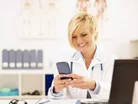Six Texting Mistakes Hospitals are Making Today

Efficient hospital communication is vital for success and the proper delivery of patient care. Messages that are transmitted in today’s hospitals are primarily related to the care and safety of patients, containing instructions, questions and test results that affect individual’s lives.
Secure forms of texting are critical, needing to be monitored while remaining HIPAA-complaint.
A recent report by Spok outlined the six major mistakes hospitals are likely to be making today and discussed why critical messages regarding patient care are not equal to ordinary texts and emails.
1. Standard texting lacks integration with staff directory/on-call schedules.
Texting plans currently exist outside of a hospital’s IT structure, meaning a group of physicians is only connected if they distribute and manually input their phone numbers into each others’ devices. If a doctor changes his/her number, there is no way to know unless prior communication is made.
The right smartphone messaging app can integrate with a hospital’s directory database, the report stated, allowing messages to be easily transmitted by choosing a contact from a list. Just as easily, determining who is on-call in a specific department can be achieved by accessing a list of available providers.
Standard texting and many secure texting apps do not maintain this level of updated contact information for the sender and staff efficiency and patient safety can therefore suffer as a consequence.
2. Standard texting cannot send system-generated patient alerts.
Standard texting applications are not equipped to receive messages from external systems. According to Spok, a secure texting app can allow a nurse to receive patient calls for assistance and determine the patient’s need. Practicing safety measures in hospitals can help streamline clinical workflows and eliminate unnecessary steps.
3. Separation between hospital notifications and personal messages cannot be made.
A single inbox for messages allows for critical hospital notifications to be mixed in with personal notes from friends and family. Due to this, an urgent message could be overlooked.
Smartphone apps designed for critical situations address this problem. “Urgent messages should be sent to a separate, secure inbox reserved for work-related notifications,” said Spok.
4. Messages sent via SMS lack encryption.
Electronic protected health information is highly sensitive and, according to Spok, there can be financial penalties for organizations that fail to protect it.
The danger with standard text messages is that they are sent unencrypted and additionally have no ability to lock the application with a secure PIN.
Healthcare organizations need smartphone messaging apps that encrypt communications until the recipient’s app is unlocked.
5. Standard texting does not provide traceability.
While some forms of texting can track messages sent and delivered, they cannot determine whether the recipient acknowledged the notification or chose to ignore it. They also cannot escalate the urgency of a message.
Leading smartphone apps track when a message is sent and delivered as well as how the user responded. Spok advises healthcare organizations to consider smartphone messaging apps that take communication to another level and automatically escalate an undelivered message if the user does not respond within a specified period of time.
6. Standard texting does not have advanced ringtone nor repeat notification abilities.
Smartphone apps designed for healthcare providers can offer priority-based ringtones for incoming messages to differentiate messages from high, medium and low priority. They can also override a smartphone’s silent mode, notifying the user of a serious message even when the ringer is off for everything else.
While the ability to send standard text messages is acceptable to stay in touch with friends and family, it is not efficient enough when it comes to patient care.
“Ultimately, better communications mean a more efficient staff and happier, healthier patients,” reported Spok.
- Regaining control over SaaS usage with Wing SecurityProcurement & Supply Chain
- Regaining control over SaaS usage with Wing SecurityProcurement & Supply Chain
- BMI Healthcare, Node4 support UK’s NHS during COVID-19TeleHealth & COVID-19
- Persistent Systems acquires Herald Health for $5.2mnTechnology & AI



